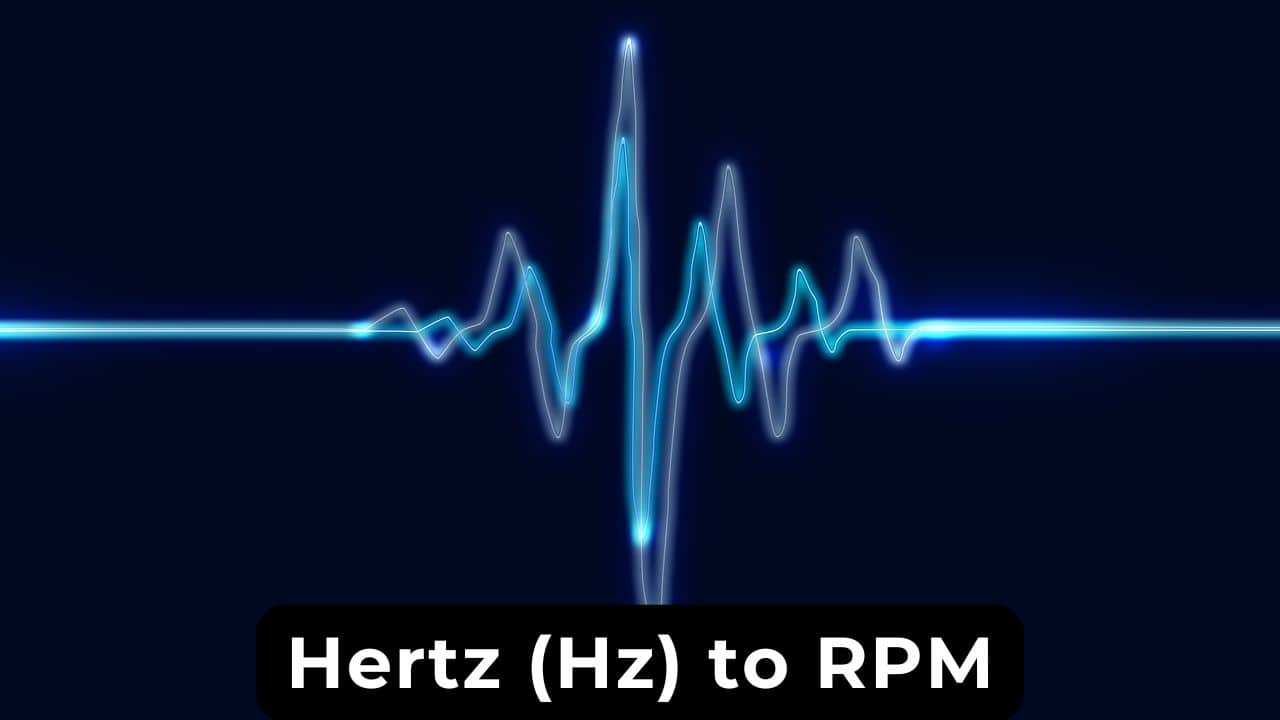
Hertz ↔ RPM Conversion
Let’s dive into the world of rotational frequency and understand the relationship between Hertz and Revolutions per Minute!
What is Frequency? (Hertz – Hz)
Frequency measures how many complete cycles or events occur in exactly one second.
Definition: When we say something has a frequency of 1 Hertz (1 Hz), it means it completes one full cycle every second.
Real-World Examples:
- Electric Motors: A small fan motor might run at 50 Hz, completing 50 rotations every second
- Musical Instruments: The A note above middle C vibrates at 440 Hz
- Power Grid: AC electricity cycles at 50 Hz (Europe) or 60 Hz (North America)
- Computer Processors: Modern CPUs operate at gigahertz frequencies (billions of cycles per second)
What are Revolutions per Minute? (RPM)
RPM stands for Revolutions per Minute – it tells us how many complete rotations something makes in 60 seconds.
Key Concept: RPM is the most common way to measure rotational speed in everyday applications, especially in engineering and automotive industries.
Understanding RPM:
Think of a clock’s second hand: it completes 1 revolution per minute = 1 RPM
- 1 RPM = 1 complete rotation in 60 seconds
- 60 RPM = 1 complete rotation every second = 1 Hz
- 3600 RPM = 60 rotations per second = 60 Hz
Real-World Examples:
- Car Engines: Idle at 800-1000 RPM, redline at 6000-8000 RPM
- Washing Machines: Spin cycle typically 1000-1400 RPM
- Hard Drives: Traditional HDDs spin at 5400 or 7200 RPM
- Ceiling Fans: Usually operate between 100-400 RPM
- Turbochargers: Can reach 150,000-300,000 RPM!
The Mathematical Connection
The conversion between Hz and RPM is beautifully simple because both measure rotational frequency, just over different time periods.
The Simple Formula:
RPM = Hz × 60
Hz = RPM ÷ 60
Why 60?
Because there are 60 seconds in one minute! If something rotates once per second (1 Hz), it will complete 60 rotations in one minute (60 RPM).
Let’s Think About It:
- Hz measures rotations per second
- RPM measures rotations per minute
- Since 1 minute = 60 seconds…
- To convert Hz to RPM: multiply by 60
- To convert RPM to Hz: divide by 60
Why This Conversion Matters
Automotive Engineering
Car engines are rated in RPM, but electrical systems (alternators, ignition timing) often use Hz. Engineers need both units for complete analysis.
Manufacturing
Machine tools use RPM for spindle speeds, while control systems often work in Hz for precise frequency control and synchronization.
Power Generation
Turbines are measured in RPM, but the electrical output frequency is in Hz. Power plants must maintain exact relationships between both.
Audio & Vibration
Rotating equipment creates vibrations in Hz, but the source rotation is measured in RPM. Understanding both helps in noise analysis.
Practice Problems for Students
Problem 1: Car Engine
Question: A car engine is running at 3000 RPM. What is this in Hz?
Click to see solution
Solution: Hz = RPM ÷ 60 = 3000 ÷ 60 = 50 Hz
Explanation: The engine completes 3000 rotations in 60 seconds, which equals 50 rotations per second.
Problem 2: Electric Motor
Question: An electric motor operates at 25 Hz. How many RPM is this?
Click to see solution
Solution: RPM = Hz × 60 = 25 × 60 = 1500 RPM
Explanation: 25 rotations per second equals 25 × 60 = 1500 rotations per minute.
Problem 3: Hard Drive
Question: A computer hard drive spins at 7200 RPM. What frequency is this in Hz?
Click to see solution
Solution: Hz = RPM ÷ 60 = 7200 ÷ 60 = 120 Hz
Explanation: The drive completes 120 full rotations every second.
Quick Reference Guide
Common Conversions:
| Hz | RPM | Common Application |
|---|---|---|
| 1 Hz | 60 RPM | Slow ceiling fan |
| 10 Hz | 600 RPM | Car engine idle |
| 50 Hz | 3000 RPM | Generator/AC frequency |
| 60 Hz | 3600 RPM | Power grid frequency |
| 120 Hz | 7200 RPM | Computer hard drive |
